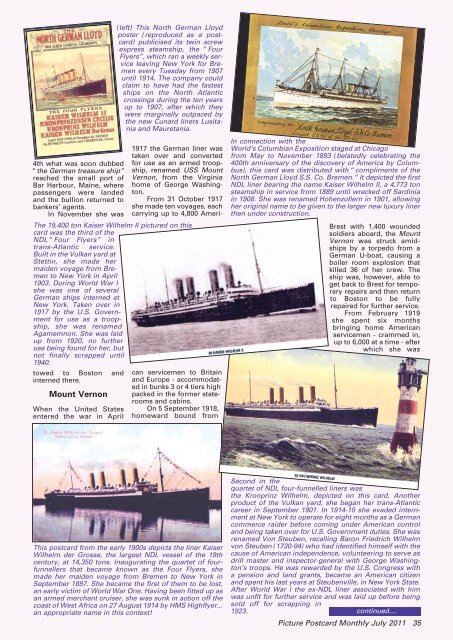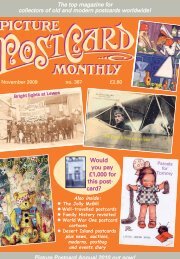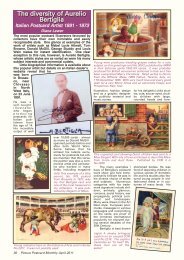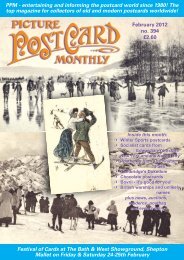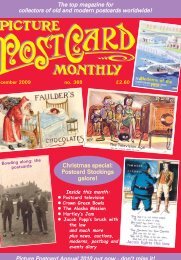Create successful ePaper yourself
Turn your PDF publications into a flip-book with our unique Google optimized e-Paper software.
4th what was soon dubbed<br />
“the German treasure ship”<br />
reached the small port of<br />
Bar Harbour, Maine, where<br />
passengers were landed<br />
and the bullion returned to<br />
bankers’ agents.<br />
In November she was<br />
towed to Boston and<br />
interned there.<br />
Mount Vernon<br />
When the United States<br />
entered the war in April<br />
(left) This North German Lloyd<br />
poster (reproduced as a postcard)<br />
publicised its twin screw<br />
express steamship, the “Four<br />
Flyers”, which ran a weekly service<br />
leaving New York for Bremen<br />
every Tuesday from 1907<br />
until 1914. The company could<br />
claim to have had the fastest<br />
ships on the North Atlantic<br />
crossings during the ten years<br />
up to 1907, after which they<br />
were marginally outpaced by<br />
the new Cunard liners Lusitania<br />
and Mauretania.<br />
1917 the German liner was<br />
taken over and converted<br />
for use as an armed troopship,<br />
renamed USS Mount<br />
Vernon, from the Virginia<br />
home of George Washington.<br />
From 31 October 1917<br />
she made ten voyages, each<br />
carrying up to 4,800 Ameri-<br />
The 19,400 ton Kaiser Wilhelm II pictured on this<br />
card was the third of the<br />
NDL “Four Flyers” in<br />
trans-Atlantic service.<br />
Built in the Vulkan yard at<br />
Stettin, she made her<br />
maiden voyage from Bremen<br />
to New York in April<br />
1903. During World War I<br />
she was one of several<br />
German ships interned at<br />
New York. Taken over in<br />
1917 by the U.S. Government<br />
for use as a troopship,<br />
she was renamed<br />
Agamemnon. She was laid<br />
up from 1920, no further<br />
use being found for her, but<br />
not finally scrapped until<br />
1940.<br />
can servicemen to Britain<br />
and Europe - accommodated<br />
in bunks 3 or 4 tiers high<br />
packed in the former staterooms<br />
and cabins.<br />
On 5 September 1918,<br />
homeward bound from<br />
This postcard from the early 1900s depicts the liner Kaiser<br />
Wilhelm der Grosse, the largest NDL vessel of the 19th<br />
century, at 14,350 tons. Inaugurating the quartet of fourfunnellers<br />
that became known as the Four Flyers, she<br />
made her maiden voyage from Bremen to New York in<br />
September 1897. She became the first of them to be lost,<br />
an early victim of World War One. Having been fitted up as<br />
an armed merchant cruiser, she was sunk in action off the<br />
coast of West Africa on 27 August 1914 by HMS Highflyer...<br />
an appropriate name in this context!<br />
In connection with the<br />
World’s Columbian Exposition staged at Chicago<br />
from May to November 1893 (belatedly celebrating the<br />
400th anniversary of the discovery of America by Columbus),<br />
this card was distributed with “compliments of the<br />
North German Lloyd S.S. Co. Bremen.” It depicted the first<br />
NDL liner bearing the name Kaiser Wilhelm II, a 4,773 ton<br />
steamship in service from 1889 until wrecked off Sardinia<br />
in 1908. She was renamed Hohenzollern in 1901, allowing<br />
her original name to be given to the larger new luxury liner<br />
then under construction.<br />
Brest with 1,400 wounded<br />
soldiers aboard, the Mount<br />
Vernon was struck amidships<br />
by a torpedo from a<br />
German U-boat, causing a<br />
boiler room explosion that<br />
killed 36 of her crew. The<br />
ship was, however, able to<br />
get back to Brest for temporary<br />
repairs and then return<br />
to Boston to be fully<br />
repaired for further service.<br />
From February 1919<br />
she spent six months<br />
bringing home American<br />
servicemen - crammed in,<br />
up to 6,000 at a time - after<br />
which she was<br />
Second in the<br />
quartet of NDL four-funnelled liners was<br />
the Kronprinz Wilhelm, depicted on this card. Another<br />
product of the Vulkan yard, she began her trans-Atlantic<br />
career in September 1901. In 1914-15 she evaded internment<br />
at New York to operate for eight months as a German<br />
commerce raider before coming under American control<br />
and being taken over for U.S. Government duties. She was<br />
renamed Von Steuben, recalling Baron Friedrich Wilhelm<br />
von Steuben (1730-94) who had identified himself with the<br />
cause of American independence, volunteering to serve as<br />
drill master and inspector-general with George Washington’s<br />
troops. He was rewarded by the U.S. Congress with<br />
a pension and land grants, became an American citizen<br />
and spent his last years at Steubenville, in New York State.<br />
After World War I the ex-NDL liner associated with him<br />
was unfit for further service and was laid up before being<br />
sold off for scrapping in<br />
1923. continued....<br />
<strong>Picture</strong> <strong>Postcard</strong> <strong>Monthly</strong> <strong>Jul</strong>y 20<strong>11</strong> 35


